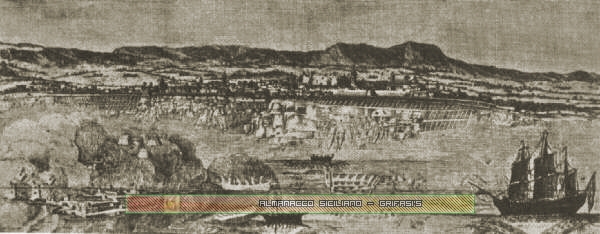|
The Strait of Messina, the ancient Fretum Siculum, is about 3 Km. wide, to the North between Capo Peloro and Torre Cavallo, and approximately 16 Km., to the South between Capo d'Alì and Punta Pèllaro in Calabria. The navigation of the Strait had scary fame in the antiquity: really it presents notable difficulties, especially for the rapid and irregular currents. Also the winds there exhale violent and sometimes in conflict between them. The principal current, caused from the flow, it is going from South to North with the name of rema montante, and the one caused from the flow in inverse direction, it is called rema scendente. They reach a maximum speed in some cases of 9 Km/h. The currents are in relationship with the position of the Sun, with the phases of the Moon and with the winds. They normally alternate every six hours, but many causes could alter the course. Generally the current reaches the maximum after 4 hours from the start, and it decreases half an hour before the opposed current settles; in this following time we have the period called by the inabithants as corrente di bilancio (balancing flow). Each current has its own bastardi, that are the reverse currents, these ones form themselves to the sides of the principal currents 1 hour after the formation of the principal one. They increase of strength together to the principal current and they decrease with them. They could have a width of 1000 meters. The bastardi one develop in known place, so boats and sailors can use them for the navigation. In the points of meeting of opposite currents, or where a current finds notable eading differences, there are formed vortexes known as garofali or refoli, of which the principal are: Cariddi, the one form with the uppercut in front of the beach of the Faro and the other due to the same uppercut, the Scilla of the ancient, that one forms on the Calabrian coast from Alta Fiumara to Punto Pizzo. These two famous vortexes derive from the bump of the waters against Capo Peloro and Punta Torre Cavallo. Cariddi has accompanied sometimes from a mingle of the waters so violent that put the small boats in danger. Notable is also the vortex that with the descending one forms in front of the Faro of Messina and with the scirocco's winds, in days of full or new Moon, causes a sea shaken between the Grotte and the waters one S. Ranieri. Other garofali are at S. Agatha, Punta Grotte, Salvatore dei Greci, Punta Pezzo and Catona. Frequently, in the crossing with the ferry-boats, the vortexes are perceived. The waters of the Strait with the uppercut sink of around 15 or 20 cm; then with the ascending get up of the same measure. Sometimes, by adding the two differences we have the sum of half a metro. The greatest depression are in August: the highest elevations in November, December and in part of February. In the days of greatest strength of the current the uppercut is always more violent than the descending and it is able to tear grasses and algas from the bottom of the sea. It causes a phenomenon also for which Messina it is known from the zoologists of all the world that are lead from the local Institute of Sea Biology. The uppercut, when it is strengthened from special meteorological conditions, blows out on the beach of Gazzirri and the Faro and also at S. Ranieri, abysmal fishes from the strange and much developed eyes, and with forms of a a great deal different from the usual fishes. Morgana fairy This special form of mirage, rarely visible almost only from the coast of Reggio Calabria, for brief time and usually with hot days and calm air and sea, it seems to approach the Sicilian bank, where the buildings and in general the objects look out upon in the sea or in the air with images oddly lengthen, deformed, that occur again continually, simulating fantastic city and also teams of men in movement. A sure explanation of the phenomenon is not known, although the phenomenon is equal in a certain sense to that of the deserts. |
The Morgana Fairy phenomenon seen from Reggio Calabria in a '700 printing
 |
|
di ricerca - grazie. |
|
Torna
alla pagina principale Back to main page |
This
page on-line since: September
11, 1998 - © 1998/2006
-All Rights Reserved No portion of this page may be copied, sold
or used in any manner without the express written consent of the owner